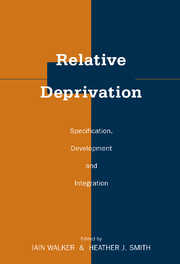Book contents
- Frontmatter
- Contents
- List of Contributors
- 1 Fifty Years of Relative Deprivation Research
- PART ONE SPECIFICATION
- PART TWO DEVELOPMENT
- 6 Personal and Group Relative Deprivation: Connecting the ‘I’ to the ‘We’
- 7 “Poisoning the Consciences of the Fortunate”: The Experience of Relative Advantage and Support for Social Equality
- 8 The Embeddedness of Social Comparison
- 9 Japanese and American Reactions to Gender Discrimination
- 10 Collective Action in Response to Disadvantage: Intergroup Perceptions, Social Identification, and Social Change
- PART THREE INTEGRATION
- Part Four Conclusion
- Index
9 - Japanese and American Reactions to Gender Discrimination
Published online by Cambridge University Press: 29 September 2009
- Frontmatter
- Contents
- List of Contributors
- 1 Fifty Years of Relative Deprivation Research
- PART ONE SPECIFICATION
- PART TWO DEVELOPMENT
- 6 Personal and Group Relative Deprivation: Connecting the ‘I’ to the ‘We’
- 7 “Poisoning the Consciences of the Fortunate”: The Experience of Relative Advantage and Support for Social Equality
- 8 The Embeddedness of Social Comparison
- 9 Japanese and American Reactions to Gender Discrimination
- 10 Collective Action in Response to Disadvantage: Intergroup Perceptions, Social Identification, and Social Change
- PART THREE INTEGRATION
- Part Four Conclusion
- Index
Summary
You need not have majored in sociology or anthropology to know that there is no society on earth in which either opportunities or burdens are distributed evenly among its members. And, as any elementary text records, all societies develop distributional norms, some of which may be codified as law. On the basis of either ascribed statuses, like family, clan, or caste, or achieved statuses, like education and training, certain roles are reserved for some people while other roles are open to other people. Almost any society relies on both ascribed and achieved statuses to distribute goods and burdens, although different societies do so in different degrees.
The effect of established distributional norms is to keep people content even when they bear a large share of the burdens or receive a small share of the rewards. As long as the burdens and rewards appear not to be disproportionate according to some internalized set of criteria, people express little sense of grievance. That deprivations are felt relative to some standard, and not due to absolute situations, is, of course, the central tenet of relative deprivation theory (Crosby, 1976; Pettigrew, 1967; Runciman, 1966).
Societies are always changing their norms. Every extant culture is a “culture in transition.” Because of interactions with other societies and because of ever-changing realities in the physical world, each society is constantly renegotiating what it sees as “normal” by way of how opportunities and burdens are divided among its population.
- Type
- Chapter
- Information
- Relative DeprivationSpecification, Development, and Integration, pp. 185 - 199Publisher: Cambridge University PressPrint publication year: 2001

